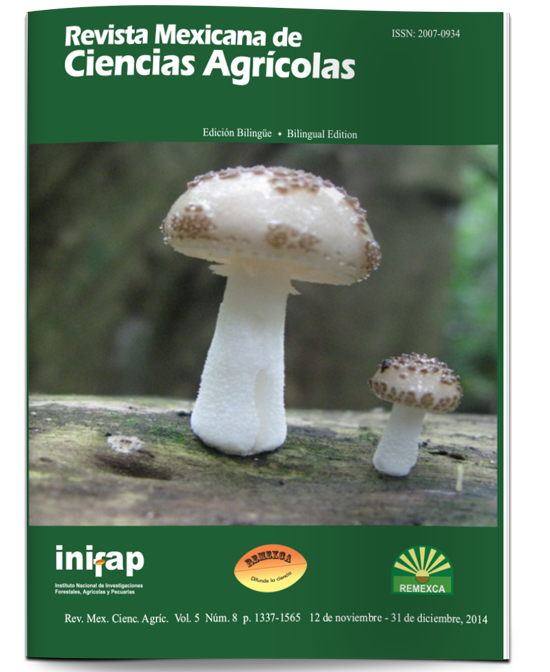Evaluation of technology to maximize the production of chile serrano in the Region Lagunera
DOI:
https://doi.org/10.29312/remexca.v5i8.835Keywords:
Capsicum annum L., crop coefficients, drip irrigation, evapotranspirationAbstract
Mexico has an extensive genetic diversity of green chile with about 40 varieties. The chile serrano is a favourite for fresh consumption for making sauces. For its adaptability, chile serrano is produced in regions that cover a wide range of environmental conditions; however, yields achieved are contrasting by the different levels of technology applied. In the Lagunera region of Coahuila and Durango, the average yield reaches 65% of the state average with the highest production of this vegetable. However, previous studies with other crops have shown that it is possible to reach and even surpass the highest producing States using improved varieties in combination of techniques such as drip irrigation and plastic mulch. The aim of this study was to evaluate technology to increase production, productivity and profitability of growing chile serrano in the Lagunera Region. We tested the commercial hybrids Camino Real F1, Montero and Arista F1, as well as some strategies to precisely control the water regime in chile serrano grown with drip irrigation and plastic mulch. These strategies involved the use of two methods for calculating water consumption and two alternatives for the placement of the irrigation tract. The results indicated that, the factors studied significantly affected yield, water use efficiency and fruit quality, achieving comparable or higher yields than those recorded in the States with the highest production.
Downloads
Downloads
Published
How to Cite
Issue
Section
License
The authors who publish in Revista Mexicana de Ciencias Agrícolas accept the following conditions:
In accordance with copyright laws, Revista Mexicana de Ciencias Agrícolas recognizes and respects the authors’ moral right and ownership of property rights which will be transferred to the journal for dissemination in open access. Invariably, all the authors have to sign a letter of transfer of property rights and of originality of the article to Instituto Nacional de Investigaciones Forestales, Agrícolas y Pecuarias (INIFAP) [National Institute of Forestry, Agricultural and Livestock Research]. The author(s) must pay a fee for the reception of articles before proceeding to editorial review.
All the texts published by Revista Mexicana de Ciencias Agrícolas —with no exception— are distributed under a Creative Commons License Attribution-NonCommercial 4.0 International (CC BY-NC 4.0), which allows third parties to use the publication as long as the work’s authorship and its first publication in this journal are mentioned.
The author(s) can enter into independent and additional contractual agreements for the nonexclusive distribution of the version of the article published in Revista Mexicana de Ciencias Agrícolas (for example include it into an institutional repository or publish it in a book) as long as it is clearly and explicitly indicated that the work was published for the first time in Revista Mexicana de Ciencias Agrícolas.
For all the above, the authors shall send the Letter-transfer of Property Rights for the first publication duly filled in and signed by the author(s). This form must be sent as a PDF file to: revista_atm@yahoo.com.mx; cienciasagricola@inifap.gob.mx; remexca2017@gmail.
This work is licensed under a Creative Commons Attribution-Noncommercial 4.0 International license.



